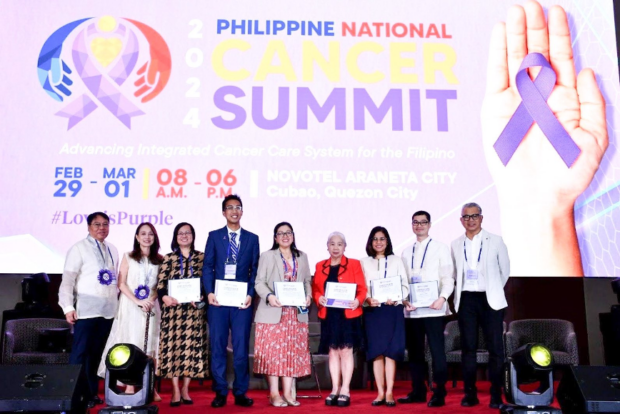Novartis session highlights key role of patient navigators in enhancing breast cancer survivorship
Patient navigators took center stage at the plenary session supported by Novartis Healthcare Philippines during the Philippine National Cancer Summit 2024. Entitled “Beyond the Pink Ribbon: Empowering Patients to Navigate the Healthcare Maze for Better Breast Cancer Survivorship,” the session convened a panel of cancer experts, healthcare champions, and civil society leaders to spotlight the critical role of patient navigators in improving cancer survivorship in the country.
Patient navigators are trained personnel who serve as guides for patients facing major health challenges like cancer. They provide patient education and emotional support and help access financial resources so the patients can focus on their health rather than being burdened with navigating the complex healthcare system.
Moderated by Ms. Kara Magsanoc-Alikpala, Founding President of the ICANSERVE Foundation, the plenary session aimed to continue driving the dialogue to streamline patient navigation, making cancer care more timely, efficient, and affordable.
“The rising cases of breast cancer cases underscores not just a call for action but a demand for change and improvement in how we detect, treat, and support those living with cancer. Like the Philippines, Switzerland believes in the power of innovation, research, and collaboration in the fight against cancer,” said Swiss Ambassador H.E. Dr. Nicolas Brühl in his opening message.
Executive Assistant for Health of Taguig City Dr. Cecille Montales shared over a decade of experience with patient navigator models that help enhance the treatment continuum in breast cancer patients in Taguig.
“Patient Navigators conduct the clinical breast exam and initial screening for cancer. Because of the support the navigators bring, patients are more likely to attend diagnostic follow-ups and treatment schedules.” said Dr. Montales.
Taguig City created the patient navigation program under local ordinances to ensure its continuation regardless of changes in the city’s political figures, something other cities could emulate to achieve sustainable cancer care efforts at the community level.
“In the Philippine context, patient navigation starts and ends in the community. When cancer patients first have symptoms, it is the community health workers who usually catch them early,” explained Dr. Frederic Ivan Ting, Co-Chair Training Committee of the Philippine Society of Medical Oncology.
According to Dr. Ting, there is sufficient data that show the efficiency of community health workers in catching early signs of breast cancer, which could translate to early detection and intervention and, ultimately, higher chances of survival.
Studies have shown that when cancer patients engage with patient navigators, compliance with the treatment journey dramatically improves cancer care compliance.[1]Moreover, five-year survival rates show even greater gains, from 39% to 70%, when patients have access to patient navigators.[2]
“One of the barriers to healthcare that patient navigators frequently deal with is the delay between the initial consult and completion of diagnostic procedures due to lack of funds. Patient navigators help patients shorten the time interval by consistently following up with them and guiding them on how to access potential financial resources,” said Dr. Claudine Ordoñez, Head of the Breast Care Team at East Avenue Medical Center.
Despite being mandated by the National Integrated Cancer Control Act (NICCA), not all hospitals treating cancer patients have navigators or have very few dedicated to this role.
Dr. Irisyl Real, Medical Oncologist from the University of the Philippines-Philippine General Hospital voiced her concern about the insufficient patient navigators in private and public hospitals.
“In PGH alone, we see 16,000 cancer consultations and about 9,000 chemo infusions per year. This easily tells us that we need a lot of patient navigators if we want to set up an efficient system,” explained Dr. Real.
Dr. Corazon Ngelangel, President of the Philippine Cancer Society, emphasized the urgent need for an effective awareness campaign for the patient navigation model to work and be adopted nationwide.
“We need a strong information and awareness campaign for patient navigation so our target people would actually know about them,” said Dr. Ngelangel
“Involving a patient navigator early on helps the patient make better decisions because they are equipped with correct and complete information right from the start.” Said Mr. Joel Chong, Country President of Novartis Healthcare Philippines.
“The cost of treatment and prices of medicines are always a concern when dealing with cancer, but there are many funds available waiting to be tapped. Patient navigators can fill these information gaps and save patients valuable time and resources so they can focus on getting better rather than worrying about finances.” Mr. Chong added.
At the end of the plenary, the panel unanimously agreed that through sustained awareness efforts and a strong push for patient navigators in the healthcare system in both the community and hospital settings, the Philippines could improve the early detection rate of breast cancer, boost survivorship, and save more lives from cancers in the years to come.
ADVT.
